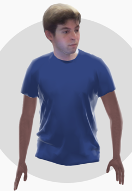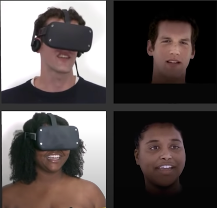Do you remember your first video call? Smartphones (and previously Webcameras) came out and changed the way we communicate and now more than ever we are relying on video conferencing tools to speak with friends, family, and coworkers.
When it comes to virtual reality (VR), you’re in a 3D space and there’s a whole additional dimension of challenges to overcome. One of these challenges is in how we choose to display avatars, the 3D virtual versions of ourselves.
There are a few ways that the industry is representing users in VR. Here is a brief look at what's currently being done:
Avatars in the Consumer Market
The VR conference platforms Spatial and Engage VR allow users to upload a photo of themselves and use an algorithm to essentially wrap the image around a 3D avatar.

This technology isn’t new, but has made some improvements over the years.
An algorithm can predict the profile of your face and automatically generate an avatar. These techniques are fairly representative of the current state of the art for social VR applications.
Avatars in the VR Development Industry
Many VR applications are being used broadly to “teach by experience”. These frequently require hiring actors to create engaging, immersive, and believable situations in VR. The content is all pre-recorded or “canned” allowing users to either experience choreographed scenes (similar to a movie) or trigger different interactions similar to NPCs in videogames.
There are tools being used now, such as Reallusion, that enable even the smallest teams to create realistic characters with fully expressive voice acting.
Reallusion provides two powerful tools. One is their character creator that allows you to manually create 3D character models and the other is an iphone app called iClone that allows you to record the character’s face in real time.

Avatars in the VR Research Labs
This software is powerful when you want to make premade content, but what about the VR conferencing tools we spoke about earlier in the article? If you want to socialize in VR you’d want your avatar to be expressive in real time.
This challenge is currently being tackled within the research community. Facebook labs for instance published an interesting paper where they were able to use machine learning to successfully track a user’s face in real time even while wearing a headset.

Slowly the industry is getting closer to fully immersive avatars. In the coming years you may be able to speak with your loved ones as if they were right next to you. While teleportation remains in science fiction, virtual reality may just be the next best thing.